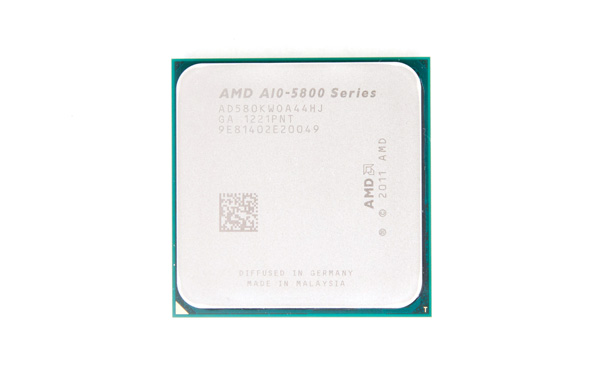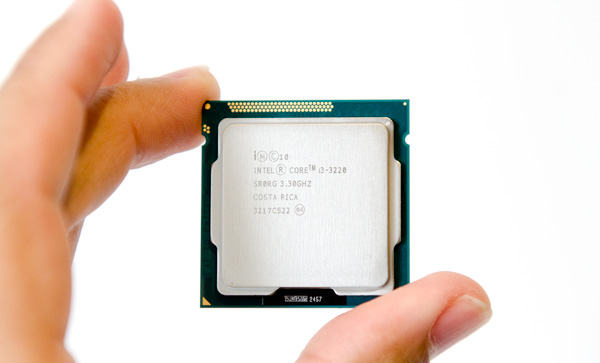AMD A10-5800K & A8-5600K Review: Trinity on the Desktop, Part 2
by Anand Lal Shimpi on October 2, 2012 1:45 AM ESTAlthough AMD's second-generation mainstream APU platform, codename Trinity, launched months ago in notebooks the official desktop launch is today. Rumor has it that AMD purposefully delayed the desktop Trinity launch to clear out unsold Llano inventories in the channel. Although selling APUs in notebooks is pretty easy, convincing desktop users to forgo the discrete GPU option (and ignore Intel) has been a tough battle for AMD. I keep going back to two slides that show us where AMD wants to go and the cores it'll take to get there:

The ultimate goal is this beautiful cohesive operation between CPU and GPU on a single die. That future will require a lot of software support, not only at the application level but also at the OS level. And I'm not talking about Windows 8. We're still far away from this APU dominated future, but AMD is marching in that direction. The second slide shows the x86 cores that we'll see from AMD along the way. AMD is still playing catch-up in the x86 CPU space and it's got a lot of lost time to make up for. There's no hiding the fact this is going to be a multi-year effort to simply get close to Intel's single-threaded x86 performance. Through pricing, leveraging its GPU technology and throwing more transistors at the problem AMD can still deliver competitive solutions, but it's not going to be a walk in the park.
Last week we took a look at the GPU side of the desktop Trinity APUs. We looked at the top end 384-core Radeon HD 7660D configuration as well as the slightly slower 256-core Radeon HD 7560D GPU, both of which easily outperformed Intel's HD 4000 and HD 2500. As far as processor graphics go, Trinity on the desktop maintains a healthy lead over Intel. There's still a place for discrete GPUs but that's pretty much at the $100 and above price points.
Today we're able to talk about pricing and x86 CPU performance among other things. The good news on that front is the most expensive Trinity APU is fully unlocked and is priced at $122:
| AMD Socket-FM2 Lineup | ||||||||
| Modules/Cores | CPU Clock Base/Turbo | L2 Cache | GPU | TDP | Price | |||
| A10-5800K | 2 / 4 | 3.8 / 4.2 GHz | 4MB | 384 cores @ 800MHz | 100W | $122 | ||
| A10-5700 | 2 / 4 | 3.4 / 4.0 GHz | 4MB | 384 cores @ 760MHz | 65W | $122 | ||
| A8-5600K | 2 / 4 | 3.6 / 3.9 GHz | 4MB | 256 cores @ 760MHz | 100W | $101 | ||
| A8-5500 | 2 / 4 | 3.2 / 3.7 GHz | 4MB | 256 cores @ 760MHz | 65W | $101 | ||
| A6-5400K | 1 / 2 | 3.6 / 3.8 GHz | 1MB | 192 cores @ 760MHz | 65W | $67 | ||
| A4-5300 | 1 / 2 | 3.4 / 3.6 GHz | 1MB | 128 cores @ 724MHz | 65W | $53 | ||
| Athlon X4 750K | 2 / 4 | 3.4 / 4.0 GHz | 4MB | N/A | 100W | $81 | ||
| Athlon X4 740 | 2 / 4 | 3.2 / 3.7 GHz | 4MB | N/A | 65W | $71 | ||
Compare this to Llano's launch where the top end SKU launched at $135 and you'll see that AMD is somewhat getting with the times. I would still like to see something closer to $100 for the A10-5800K, but I find that I'm usually asking for a better deal than what most CPU makers are willing to give me.
AMD's competitive target is Intel's newly released Ivy Bridge Core i3 processors. There are only five Core i3s on the market today, four of which use Intel's HD 2500 graphics. The cheapest of the lineup is the Core i3 3220 with two cores running at 3.3GHz for $125. Intel disables turbo and other features (there's effectively no overclocking on these parts), which AMD is attempting to exploit by pitting its Trinity K-series SKUs (fully unlocked) against them. AMD's TDPs are noticeably higher (100W for the higher end K-series parts compared to 55W for the Core i3s). Intel will easily maintain the power advantage as a result under both CPU and GPU load, although AMD's GPU does deliver more performance per watt. Power consumption is a major concern of AMD's at this point. Without a new process node to move to for a while, AMD is hoping to rely on some design tricks to improve things in the future.
At the low end of the stack there are also two Athlon X4s without any active GPU if you just want a traditional Trinity CPU.
The Test
This will be our last CPU/APU review on the current test platform/software configuration. The next major CPU review will see a move to a brand new testbed running Windows 8. As always you can get access to far more numbers than what we report here if you use our performance comparison engine: Bench. Of course if you want to see the GPU and GPU Compute performance of AMD's Trinity APU check out part one of our coverage.
| Motherboard: |
ASUS P8Z68-V Pro (Intel Z68) ASUS Crosshair V Formula (AMD 990FX) Gigabyte GA-F2A85X-UP4 (AMD A85X) Intel DZ77GA-70K (Intel Z77) |
| Hard Disk: |
Intel X25-M SSD (80GB) Crucial RealSSD C300 OCZ Agility 3 (240GB) |
| Memory: | 2 x 4GB G.Skill Ripjaws X DDR3-1600 9-9-9-20 |
| Video Card: |
ATI Radeon HD 5870 (Windows 7) AMD Processor Graphics Intel Processor Graphics |
| Video Drivers: | AMD Catalyst 12.8 |
| Desktop Resolution: | 1920 x 1200 |
| OS: | Windows 7 x64 |













178 Comments
View All Comments
CeriseCogburn - Friday, October 12, 2012 - link
AMD's engineers can't seem to figure out pci-e 3.0They released their 7000 series with pci-e 3.0 uncertified (while nVidia waited and did a proper and offical implementation), then a bunch of amd card people had trouble in boards, but since the "press" kept their yappers shut except for a few, it wasn't widespread knowledge, so amd fanboys ( and others) suffered with their crap non certified cards, unable to chase down the plaguing glitches properly.
rarson - Wednesday, October 3, 2012 - link
"So as of today, in general - it costs more to get an AMD."...unless you actually want decent gaming performance.
The problem for Intel is that the things that Trinity doesn't do well aren't much of an issue to the average consumer. The average consumer doesn't have a clue how threaded their workloads are, and won't notice any significant differences between the i3 and the A10 other than how much faster the graphics are.
If I were going to build an HTPC without discrete graphics, I'd be buying a Trinity. Intel doesn't make sense in that application (of course, I'd probably still go discrete, in which case Intel makes more sense).
CeriseCogburn - Friday, October 12, 2012 - link
That's great rarson, when amd is crap, it's ok because people need crap, and won't notice the crap they have.LOL
Someone may be full of crap.
g101 - Monday, October 22, 2012 - link
Yeah, you. You lifeless little shit. Find something better to do than comment on every anandtech article with senseless garbage that never contains a shred of evidence or fact.rarson - Wednesday, October 3, 2012 - link
"I think there is very little need for raw single-threaded performance increases in consumer-level "general computation" processors (e.g. few-core x86 processors)."Exactly. While AMD could stand to improve their single-threaded performance, the fact that Intel is so far ahead in that specific metric doesn't automatically mean that Trinity is "slow." It does other things quite well, including multi-threaded performance, which is obviously more of a concern at this point considering software is moving towards multi-threading anyway.
CeriseCogburn - Tuesday, October 9, 2012 - link
LOL - you are such a sad fanboyI hope amd showers you as fanboy of the month with their slow crap so you have to use it.
amd4evernever - Sunday, October 14, 2012 - link
http://www.tomshardware.com/reviews/a10-5800k-trin...choke on that.... no matter how you troll the amd solution in the ends beats the core i3 both in price and in gaming read the full article at tomshardware.. you lunatic.
g101 - Monday, October 22, 2012 - link
You stupid little bitch, you comment on EVERY article with pro nvidia/intel comments and every single one is absolute rubbish.What I really want to know is: how the fuck can you have nothing better to do, yet still be so ignorant?
rarson - Wednesday, October 3, 2012 - link
"We need this for some real progression to be made in desktop CPU's and also drive prices down at the high end."Why? Is an i7 not fast enough for you? Are you being bogged down by your uber-user workload?
The vast majority of people buy processors that are cheaper than the A10 here. Sure, it'd be nice to see AMD compete at the high end again, but the high end doesn't drive the market; the high end is barely a blip on the radar.
Flunk - Tuesday, October 2, 2012 - link
Exactly, why buy the kids a new A10 when I can just give them my old Q6600? AMD really needs to make a better case for themselves than this.